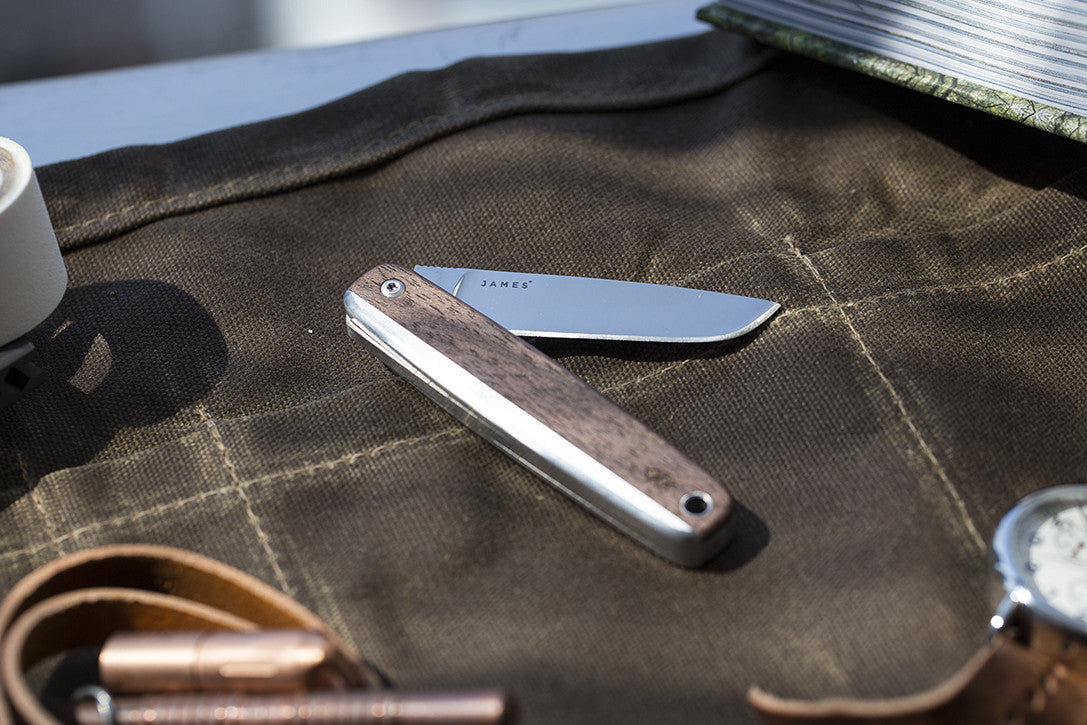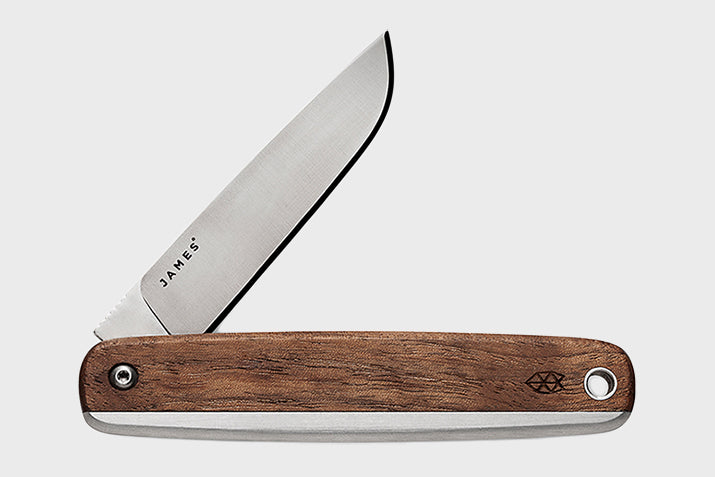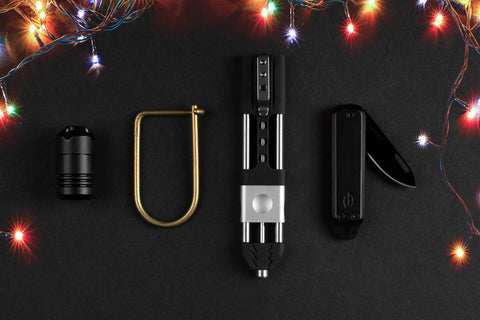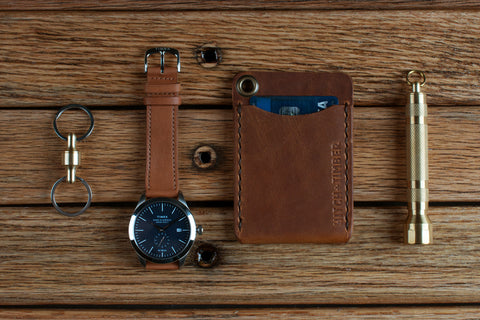The Complete History Of The Pocket Knife

Forgive us for stating the obvious, but the term 'pocket knife' refers to a handled blade which can be carried within a person's pocket. And the most common iteration is the folder - a knife which has the ability to collapse into itself for easy, convenient, and safe portability. Typically, their blades fall between 2-6 inches in length and are made of some type of steel alloy. The handles are most often composed of metal, synthetics, and/or naturally occurring materials like wood or stone. And, though common conception would like to dictate otherwise, they are more practical tool than deadly weapon. What you may not know, however, is that the story of the pocket knife is thousands of years in the making and dates back further than the Roman Empire.
Antiquity
The 'jackknife' - an alternative term for a very basic folding knife - is said to originate somewhere in the Germanic regions of Europe, north of Italy, and dates back to between 600 and 500 BCE, though the evidence is hard to substantiate. What can be said is that these knives were fairly primitive in their construction. They consisted of a very plain handle and a somewhat unwieldy blade attached via a simple hinge - with no lock nor spring to keep it closed and/or open of which to speak.
With the rise of the Roman Empire came a multitude of technological advances throughout the known world. While folding knives remained much the same in regards to form, the quality of materials and designs improved. Archaeological digs have elicited examples of ornate 'friction folders' - a folding knife whose blade is held in place by the grip of the wielder due to an extended tang (a projection from the base of the blade) - made from metals such as copper, iron, and steel. Such examples can be traced back as far as 43 CE.
In other parts of the world - even before the complete collapse of the Roman empire - several cultures had developed their own versions of compact folding knives. For example, the Vikings created their own swiveling friction folders with iron blades and carved bone handles around the 8th to the 11th centuries. In fact, it is said that these kinds of folding knives - also known as penny, peasant, or farmer knives - were a popular tool throughout both the Viking and Medieval periods, especially amongst craftsmen and in agrarian communities.
The Slipjoint

James Brand The County Knife
According to Simon Moore in his book, Penknives and Other Folding Knives, the slipjoint - a mechanism that uses spring tension to keep a pocket knife blade extended - was invented sometime around the mid-1600s in England. Undeniably a titanic influence on pocket knives and a major part of their advancement, the slipjoint is still widely used today - even by more recently established modern knife makers, such as The James Brand. Slipjoint folding knives became widely popular with scholars and authors, to the point that they were referred to as penknives, for their usefulness in thinning and pointing quills for use in writing.
Unfortunately, because of its ability to be easily concealed, the slipjoint folding pocket knife also became the favored weapon of bandits and thugs, especially in places where there were strict laws regarding the carrying of guns, swords, and/or fixed-blade knives - such as Spain during the rule of King Ferdinand VII. In his book Sevillian Steel, James Loriega notes a popular style of folding knife that was used in a form of Spanish knife-fighting (called el Baratero) by gypsies (Gitanos, alternatively) who would frequently rob unsuspecting travelers. That knife, the navaja (derived from the Latin word for razor), is one of the oldest slipjoint folding knife styles still in production today. And the Baratero knife-fighting style is practiced by modern aficionados of the old form of combat to this day.
Victorinox and Opinel

Opinel No. 8 Trekking Knife
Opinel and Victorinox are by no means the Alpha and the Omega of the pocket knife world, but their overall influence and well-earned respect cannot go without mention - as, together, they changed the landscape of the knife world forever. And the fact that both of these family-owned behemoths still exist and craft many of the same knives that made them famous is impressive in its own right. However, what is perhaps the most interesting coincidence surrounding these two companies is how closely in time they came into existence while still traversing two vastly differing yet similarly influential paths.
1884: Karl Elsener opens a knife cutler's workshop - a factory specializing in the manufacturing of cutlery knives - in Ibach, a village in the Schwyz region of Switzerland. Victoria, his mother and the company's namesake, is perhaps his biggest supporter.
1890: Joseph Opinel turns 18 and begins working in his family's edgetool making workshop in the Savoie region of France. Driven by a passion for innovative technology, machinery, and manufacturing processes, he speds his free time working on developing and refining his own design for a small pocket knife. It is here that Opinel was born.
1891: ASMC - the Association of Swiss Master Cutlers - is established by Karl Elsener and, as a result, he has the ability to deliver the first major order of soldier's knives to the Swiss army.
1897: Joseph Opinel develops 12 different numbered versions of his original knife that are suitable for different tasks and/or hand sizes. The smallest, No. 1, comes with a ring so it can be attached to a pocket watch.
1897(cont.): Karl Elsener is awarded a patent for the original Swiss Officer's and Sports knife.
1921: Stainless steel is invented and revolutionizes the cutlery industry. The international term for stainless steel - Inox - is combined with Karl Elsener's mother's name and the company is dubbed Victorinox.
1945: As a result of WWII and the influx of international soldiers in Europe, the Swiss Army Knife becomes popular worldwide. American soldiers purchase them en masse as a souvenir to take home.
1955: Marcel Opinel, Joseph Opinel's son and successor, invents the Virobloc - a rotating ring-lock designed to hold the folding blade in the open position - as a means to make Opinel knives safer and more stable. A modernized version of this rotating lock is still used on Opinel knives today.
1998: Denis Opinel, grandson to Joseph Opinel, takes over running the family business
2014: Victorinox celebrates its 130th anniversary. The company is now managed by the fourth generation of the Elsner family.
American Made

ZT 0450 Sinkevich Titanium Flipper
While there are a multitude of respectable international companies that make high-quality pocket knives, there's something to be said for the craftsmanship and grit of American knife makers. Here in the States, we have a long and storied history of pioneering, both in regards to physical exploration and through the development of manufacturing and workmanship. And we wouldn't be doing our jobs properly if we didn't mention some of the people that helped form that reputation, as well as those who keep it alive.
Camillus: Formed in 1876, Camillus is one of the oldest American knife manufacturers. While their focus was/is not strictly on the creation of pocket knives, they have made some notable entries. Namely, they manufactured a folding knife/spook for the Red Cross during WWI. In 1947, they created a full line of official folding knives for the Boy Scouts of America. They also manufactured a 4-blade utility knife for the U.S. Armed Forces during the Vietnam War. Unfortunately, they went bankrupt in 2007 as a result of their inability to compete with overseas competition. Now they are owned and operated by Acme United Corporation and, as far as we can tell, no longer manufacture American-made folding knives.
Buck Knives: Though the first Buck Knife was made in 1902, it wasn't until 1961 that Buck Knives became an incorporated company. In 1963, Al Buck - son of the late Hoyt Buck - created their Model 110 Folding Hunter pocket knife. It is still one of the most popular models they offer today. Buck Knives had gone through a period where they sourced much of their business overseas, but have since been trying to find ways to move production back to the USA. Today, they manufacture about 80% of their knives out of their Idaho facility. They also offer a limited "forever" warranty on all of their products.
Benchmade: Creators of the widely lauded line of Griptilian knives, Benchmade is one of the newer pocket knife makers to have come onto the scene, but they have certainly earned a tremendous amount of respect from the knife community. With roots dating back to 1979, Benchmade was incorporated in 1990 - in California. Today, they manufacture more than 90% of their knives out of their Oregon City factory.
Gerber: Founded in 1910 as an advertising firm, they began manufacturing their line of Gerber Legendary Knives in 1936 after Joseph Gerber mailed off 24 sets of kitchen knives to clients, receiving a wildly positive response. Many highly respected American knife designers have since worked with the company and many of their models are still manufactured here in the U.S.
Spyderco: Named for the spider-like appearance of founder Sal Glesser's first invention, the Portable Hand, Spyderco has been producing folding knives since 1981. Based out of Golden, Colorado - a fact not-so-subtly stated on all of their knives - these folks have been on the forefront of some pretty important knife technologies, like using powder metallurgy in the production of their knives, and their unique design stands out in the pocket knife world.
CRKT: Standing for Columbia River Knife & Tool, CRKT has been making high quality American knives since 1994. Like Spyderco, they have embraced the forward-thinking side of knife making and own the rights to several proprietary technologies. They also emphasize both excellence and affordability, believing that everyone should have the opportunity to carry with them high quality knives.
W.R. Case & Sons Cutlery Co: More commonly referred to as Case, this brand dates back to 1889, when the Case brothers began selling cutlery out of the back of a wagon in western New York. Starting in WWI, the brand was responsible for manufacturing military knives - including both the M3 Fighting Knife and the V-42 Stiletto. Today, they are owned by Zippo, although all their knives are still made in the USA with domestically sourced steel and natural materials like buffalo horns, precious stones, and ancient mammoth ivory.
Modernity

DPx Gear HEST F Shred
Since the 1800s, pocket knives have seen exponential growth in both style and technology. From culturally distinct design developments - like the Japanese Higonokami, the French Douk-Douk, or the Italian Stilleto - to widely utilized mechanical advancements - such as the wide variety of different locking systems or the creation of new, stronger steel alloys - pocket knives have evolved far beyond their original inception while still retaining the core of their utility.
Now there are hundreds of different styles and materials, dozens of different blade steels, and countless knife makers and designers around the world. And our planet has become a much smaller place in the age of the internet and the era of globalization. Whether you're looking for a simple camping knife or the most extreme American-made tactical folder ever imagined, you can find it out there somewhere. Or you can have it custom made, if you're not one to relish in the chase. By the way, the term 'tactical folder' was coined by Bob Terzuola, the man who literally wrote the book on tactical folding knives.
So find that perfect pocket knife and carry it with you every day. Over a thousand years of history and development have given you the opportunity to get your hands on one of the most useful tools mankind has ever known. One that you'll probably end up using a lot more than you might think. And if you've already got a solid EDC pocket folder, it doesn't mean you can't expand your choices. Try something new. Add some alternative options to your collection. There's a world of heritage and progress that has gone into every single pocket knife. And it would be a real shame not to explore it.
© Photography by Gallantry







